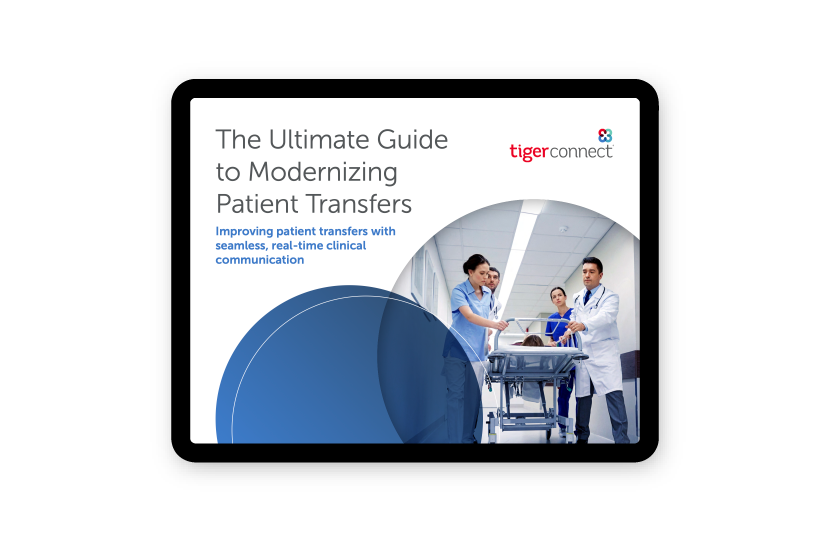Home / Blog /
Modernizing Patient Transfer Workflows

Modernizing Patient Transfer Workflows
Patient transfer workflows are one of the most challenging clinical workflows healthcare providers face – due to the number of clinicians involved and fragmented communication. Many healthcare organizations use a combination of pagers, faxes, and phone calls to coordinate patient transfers. These antiquated communication methods can significantly delay patient transfers and negatively affect the patient’s care quality. Studies show that 80% of serious medical errors were attributed to miscommunication during patient transfers.
Patient transfer workflows are at the center of a problem impacting healthcare systems that are experiencing higher patient volumes than ever before, affecting a variety of care team members and facilities. Transfers can take hours to complete when who needs to be contacted is unclear, and communication with them is cumbersome. This blog discusses how improved communication tools can benefit the following key patient transfer workflows:
- Emergency department to inpatient transfers
- Skilled nursing facility transfer
- Inpatient floor-to-floor transfers
- Facility-to-facility transfers
Improve Patient Transfers with Better Communication and Collaboration
|
 |
Emergency department to inpatient transfers
In the emergency department (ED), every second counts. The same is true for ED to inpatient transfer workflows. This workflow involves a range of touchpoints and communication requirements between care team members, including providers, nurses, house supervisors, and bed control coordinators. Communication delays in this workflow lead to longer patient wait times and a potential decrease in patient satisfaction.
A clinical communication and collaboration platform makes it easier to facilitate real-time communication between the ED and the receiving inpatient unit. Seamless and rapid communication allows instant sharing of patient information to the right person – reducing the dependence on phone calls, pagers, and voicemails.
Inpatient Floor-to-Floor transfers
Clear communication across providers is essential when patients are transferred across inpatient units. Multiple roles must be in lock-step communication, including providers, charge nurses, and supporting staff. When the care team members are not on the same page, the potential for critical patient information to either be missed or delayed is extremely high.
Communicating in real-time increases the efficiency of inpatient floor-to-floor transfers. Secure messaging within a clinical communication and collaboration platform streamlines this workflow by confirming that the patient’s care team members are informed of the patient transfer details.
Skilled nursing facility transfers
Transferring a patient from a hospital setting to a skilled nursing facility is one of the most challenging patient transfers. Case managers must call different facilities to not only confirm they have patient capacity but that they are also equipped to care for the patient. Often, this means many back-and-forth phone calls while the patient is left waiting. In this workflow, seamless clinical communication between case managers and skilled nursing facilities can reduce the time spent searching for an appropriate facility and coordinating the patient transfer.
Using a clinical communication and collaboration platform to facilitate skilled nursing facility transfers results in streamlined patient handoffs. Case managers can clearly communicate the patient’s needs via secure messaging and receive a notification the moment a facility responds. Patient transfer details, including important documents, can also be shared in real-time to speed up the transfer process.
Facility-to-facility transfers
Transfer centers are essential for streamlining the safe transfer of patients from one healthcare facility to another. Facility-to-facility transfers are incredibly complex, with a typical workflow exceeding 150 minutes from initial facility placement to completion of the transfer request. Inefficient communication, such as phone calls to the target facility in hopes of finding the correct on-call hospitalist available to talk, can slow down facility-to-facility transfers. This type of workflow puts patient safety, patient satisfaction, and referral leakage at risk.
A clinical collaboration platform empowers transfer centers to seamlessly manage transfer requests by improving communication with sending and receiving care teams, facilitating faster patient transfers. Additionally, by integrating with on-call schedules, transfer center staff can easily message the on-call hospitalist by role, eliminating the need for back-and-forth phone calls and consulting on-call schedules.
Improving patient transfer workflows with TigerConnect
Improving communication in patient transfer workflows is crucial to improve the efficiency of the transfer process while improving the patient experience. With an unmatched patient volume and clinicians struggling to efficiently communicate and make real-time decisions, the TigerConnect Clinical Collaboration Platform is the best solution to streamline patient transfer workflows. Secure messaging via TigerConnect Roles and Teams makes it easy for everyone to communicate in one place, ensuring that everyone is informed of the patient transfer details.
The ability to securely share patient information between the accepting and sending care teams, such as lab results, X-rays, and vitals, ensures that patients receive the care they need in a timely manner. In addition, replacing phone calls and pages with asynchronous secure messaging results in faster responses, reduces the burden on clinical staff, and increases provider satisfaction.
Now’s the right time to improve your patient transfer workflows. Read the eBook, The Ultimate Guide to Modernizing Patient Transfers, to learn more.
Tags: Patient transfers, Clinical Communication and Collaboration, Clinical Collaboration, Clinical Communication, Clinical Workflows








